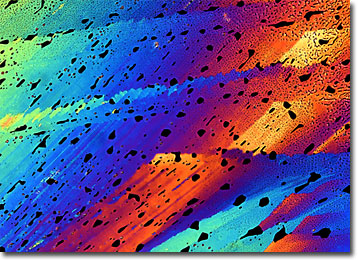Polarized Light Microscopy Digital Image Gallery
Heliotropin
In recent years, there has been a significant increase in interest in aromatherapy, a type of treatment that involves the use of certain fragrant substances to help control moods and promote wellbeing. Thus, increased attention has also been given to heliotropin, which is one of the substances commonly used in aromatherapy since it exhibits a sweet, vanilla-like aroma.

Widely utilized in the perfume and soap industries, heliotropin is a derivative of safrole, an oily, aromatic biochemical that occurs naturally in Sassafras albidum, Cinamomum petrophilum, and various other botanical sources. Studies have shown that safroles display antiviral and antibacterial activity, but their use in edible items has been banned in the United States due to their carcinogenic and hepatoxic characteristics. Consequently, safrole derivatives are not generally considered nutritional phytochemicals, although heliotropin is sometimes utilized in products marketed as imitation vanilla extract. Instead, the chief appeal of the safrole derivatives is their aromatherapeutic properties. Indeed, purified heliotropin crystals are sometimes sold in stores alongside aromatic oils, though the distribution of the substance is becoming increasingly regulated due to its potential use in the illegal production of ecstasy and other designer drugs.
In the early 1990s, research carried out by the Memorial Sloan-Kettering Cancer Center in New York helped establish heliotropin as a powerful aromatherapy tool. In the study, patients who were undergoing magnetic resonance imaging (MRI), a procedure that necessitates lying still in the narrow cylindrical core of a scanner for as long as an hour, were exposed to five different fragrances in an attempt to determine their effect on anxiety during the stressful procedure. The research group found that heliotropin, which is also known as piperonal or the oil of sassafras, was more relaxing and pleasant to patients than any of the other scents studied. In fact, patients who were scanned in an environment scented with heliotropin felt 63 percent less anxiety than those who were not exposed to any fragrance.
